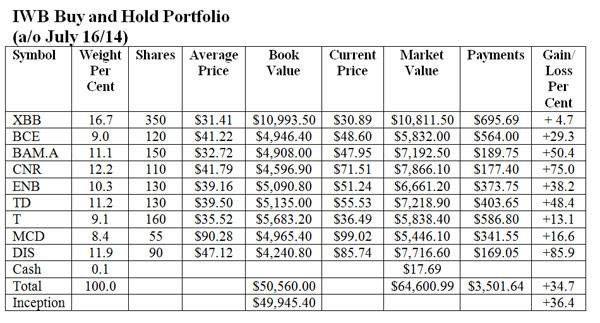How to build a portfolio of monthly dividends The Globe and Mail
Post on: 20 Апрель, 2015 No Comment

You want monthly investment income? More than 100 companies listed on the Toronto Stock Exchange are ready to serve it up to you.
60-SECOND RRSP TIPS
Paying dividends monthly is a win-win for both investors and companies. Investors benefit from being better able to match income and living expenses, and companies gain a loyal shareholder base.
“Monthly income is a pretty big deal,” said Harry Levant, the analyst behind the website IncomeResearch.ca. “There’s a preference for it due to aging demographics and it makes a stock more attractive to the investors.”
In the past few weeks, the Portfolio Strategy column has discussed ways to generate income in retirement. We’ve looked at using monthly income mutual funds and exchange-traded funds and at annuities. Here, we consider another option – a portfolio of monthly pay dividend stocks.
Blue-chip dividend stocks are certainly an option, too. But with their quarterly payout schedules, you’ll need to do some work to synch your income flow and expenses. Doable? Certainly. Convenient? Not so much.
Monthly pay stocks are mainly ex-income trusts that converted themselves into dividend-paying corporations. Some remaining trusts are also in the group, as are some new players that use trust-like structures. Also in the group is at least one big company: Shaw Communications.
Mr. Levant is an expert on small monthly dividend payers – a growing segment in the Canadian market. Newcomers to the group include several energy trusts with assets that are located in the United States and thus not covered by the federal rules that virtually wound down the trust sector several years ago. Other new entrants include real estate investment trusts, or REITs, which have been a particularly hot market sector in the past couple of years.
Mr. Levant suggests using 20 to 30 different monthly dividend payers to fill out the equity portion of a diversified portfolio. Adding blue-chip dividend stocks to the mix is both possible and sensible for investors who are nervous about buying smaller, more obscure stocks.
However, he said using only monthly pay dividend stocks is not excessively risky. “I’m pretty comfortable with it. There’s enough diversification now between sectors, and there’s some pretty decent quality in there.”
The income trust predecessors of today’s monthly pay stocks included both durable businesses and duds that ended up cutting or suspending their payouts. Mr. Levant said that if you stick to quality names, you should be able to minimize the potential for disappointment.
Back in January, 2011, he provided this column with a list of recommended small-size dividend payers that he has monitored ever since (see the list online ). “I haven’t changed a single name, but then we don’t advise a lot of activity. We advise more patience and buying good quality names.”
Analyzing monthly dividend payers requires close attention to their adjusted funds from operation (AFFO), which is a measure of cash flow. Mr. Levant looks at both trailing and forecast AFFO or, in other words, data for the past year and what’s predicted for the 12 months to come.
Calculate dividends as a percentage of AFFO and you get the payout ratio – a key measure of a company’s ability to both continue dividends and reinvest in the underlying business. Unless there are exceptional circumstances, Mr. Levant wants to see a payout ratio consistently under 100 per cent. He said 50 per cent is ideal, and there are companies below that level. However, they tend to offer investors less regular income and more potential for capital gains.
A reliable, sustainable dividend is Mr. Levant’s top priority in assessing stocks, with the possibility of capital gains a definite second. “Strangely enough, sometimes the sustainable, reliable payout provides the better capital appreciation.”
If you hold monthly pay stocks in a non-registered account, expect a mix of tax-advantaged dividend income and return of capital, which has the effect of lowering the cost of the stock that you will use at some point in the future to calculate your capital gain (or loss) when you sell.
The reason to buy a stock is that it represents a productive and sound investment opportunity, not because it pays monthly income. Fortunately for our aging and increasing income-hungry population, you can have both.
Ready, steady, invest

Here are five companies analyst Harry Levant of IncomeResearch.ca selected as a good place to start for investing in stocks that pay a monthly payout. Each offers very stable payouts with reasonable potential for future increases.
Since disposing of two thirds of their properties, Dundee’s portfolio has been rebuilt at attractive prices to become Canada’s fourth-largest REIT by property value. Market rents are expected to be renewed at higher than current rents for the next three to five years.
Enbridge Income Fund Holdings (ENF-T )
“Enbridge provides low-risk exposure to petroleum infrastructure and electric power generation segments backed by long-term, good-credit-quality contracts, plus they have an active capital development and acquisition program,” Mr. Levant says. “Enbridge Corp. (ENB) owns approximately 70 per cent and will continue to be a source of acquisitions and a partner for Enbridge Income Fund Holding’s endeavours.”
“Their facilities are integral to the western Canadian petroleum infrastructure, including $2-billion of capital projects to add pipeline capacity to and from the Alberta oil sands over the next four years,” he says. “The recent expansion in the European liquids storage business provides another major avenue for growth.”
They are in process completing the “The Bow” office complex in Calgary, the largest construction project in the REIT’s history, as well as the acquisition of Primaris REIT. Once these initiatives are completed, H&R will be the largest diversified REIT in Canada. H&R has raised distributions steadily to re-establish the dividend at nearly the level of that prior to the global financial crisis.
Medical Facilities Corp. (DR-T )
Owns a 51 per cent interest in five specialty surgical hospitals located in South Dakota, Oklahoma, and Arkansas, as well as 51 per cent of a facility in California. Minority interests in the hospitals can be owned by the resident practitioners. U.S.-dollar earnings and dividends provide a hedge against weakness in the Canadian dollar.
For more personal finance coverage, follow Rob Carrick on Twitter (@rcarrick ) and Facebook (robcarrickfinance ).














